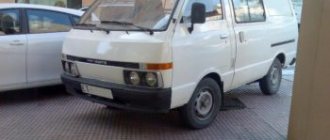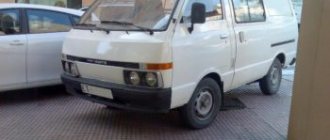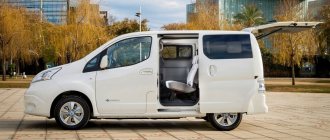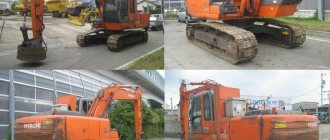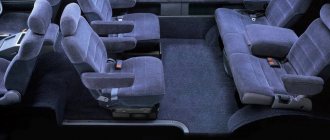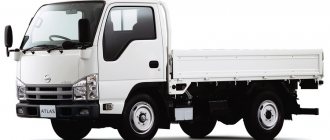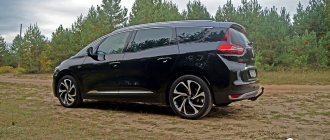| On such bends in dirt roads with an empty body, you can easily lose the point of support at the rear drive wheels |
| The truck has low ground clearance |
But to say that we have a 25-year-old car in our hands is wrong, since in 1999 the model underwent the most significant modernization in recent times, in which gasoline engines (1.8 and 2.0 liters) received distributed fuel injection, diesel engines (2.0 and 2.2 liters) have an electronically controlled injection pump, and the body has been modified to meet the latest requirements for passive safety at that time.
Well, the guest of our “Tribune” was a 2001 Nissan Vanette Truck, with a 1.8-liter gasoline engine with fuel injection, a 5-speed manual transmission, rear-wheel drive and an all-metal flatbed body. Among the additional equipment, the Vanette has a radio and air conditioning, providing the driver with a minimum level of comfort. However, the simplicity of the configuration can be justified in terms of the cost of the car: Bongo and Vanette (as well as the third “brother” named Mitsubishi Delica Truck, which appeared in 1999) produced in 1999-2001 cost from 180,000 to 230,000 rubles. At the same time, they have almost no competitors, since similar trucks from Toyota (TownAce and Lite Ace) have recently been seen on sale much less frequently, Vanette and Bongo. So we began to wonder - are these machines really so good for their purposes, or is their popularity based on the fact that there is no alternative? Simple pleasure
| The small cabin of the truck has a lot of luggage compartments and shelves for documents and various small items. |
It just so happened that several years ago I was the owner of a Vanette diesel passenger minibus, and I had the opportunity to drive a cargo-passenger Mazda Bongo and a Toyota TownAce mini-truck (both with gasoline 1.8-liter engines and automatic transmissions).
So I can't resist making comparisons. First of all, ergonomics: today's Vanette and Bongo (in fact, these are the same car) are slightly inferior to my old Vanette in that they have a shallower steering wheel and a frankly high bus-truck driving position. In addition, the cargo Vanette has much worse gear shift selectivity, the outside rear-view mirrors are very modest, and of all the options there is only air conditioning and a radio (and even that only picks up the first television channel, naturally, without an image) - these are already aspects of the equipment. As for comfort, then, naturally, a passenger minibus, even with springs at the rear, is a priori more comfortable than its utilitarian “colleagues”. However, the gasoline engine in the cargo Vanette (as well as in the Bongo) does not bother the ears even with mediocre sound insulation (here, Toyota is an outsider). But in motion, the cargo Vanette puts its opponents on both shoulder blades: the diesel car, due to the characteristics of the engine, was distinguished by measured acceleration, and both automatic ones accelerated from a standstill as if they had a piece of concrete dragging on a cable behind them. At the same time, any of the cars can be accelerated to 120 km/h (and even faster!), but only driving trucks at such a speed can you feel like Schumacher.
| The pedal assembly with the steering column between the legs takes some getting used to, especially the high brake and clutch pedals |
It’s a pity that we weren’t able to find a couple of dozen bags of potatoes in advance in order to test the car in the form in which it spends most of its time.
Then, for sure, the smoothness of the ride would seem simply excellent, and on seemingly harmless bends in the primer the car would not stop with the rear wheel hanging out, and the metal sides of the body would not rattle on the supposed asphalt. But even without this, impressions of the cargo Vanette remained positive. Yes, there are a minimum of options (not even a passenger sun visor!), very simple finishing materials and very specific access to the engine. But for a purely utilitarian vehicle, such characteristics as reliability, carrying capacity, maneuverability, etc. are more important. And I think I understand why some families buy a mini-truck as a second car - it’s an invaluable vehicle on the farm. But if you want, you can get pleasure from driving this truck, and no less than driving a hot sports car! His destiny is to work
Alexey Stepanov
| The instrument panel looks a bit sparse. A tachometer would be nice here |
Trucks are a separate issue.
To people who deal only with passenger cars, everything about them seems frivolous or too simple. However, the design of the truck, the design and equipment of the interior must be considered primarily from the point of view of its suitability for performing the assigned tasks. According to the Japanese classification, our Vanette is a “baby”; the permissible load capacity of 850 kg is indicated on the body. Taking into account the weight of the driver and passengers, it can transport a ton. An ordinary universal flatbed delivery truck. The cabin is spartan in simplicity, with a simple radio, push-button air conditioning and power steering. The steering is light, the car turns with a minicar radius of 4.5 meters!
| The 1999 interior is simple but still pleasing to the eye. |
The driver's seat is uncomfortable from the point of view of a passenger car driver. Between the legs there is a steering column, the steering wheel is located almost horizontally, your feet on the brake and clutch pedals must be raised, not put down. And then my right elbow knocks on the door. Getting behind the wheel, despite the apparent cramped space, is quite comfortable. The driver's seat has a slight adjustment back and forth, and people of average height can adjust the seating position, but tall people will find it uncomfortable. I adjusted after half an hour, but my right elbow was constantly hitting the door. You can roll down the window and just rest your elbow while it's warm outside. Many people, by the way, drive like this, only the edge of the door is a little high, again inconvenient. Visibility from the cabin is almost optimal, helped by the mirrors. Only when looking over the right shoulder does the rear pillar get in the way.
| The truck is a bit small compared to the mixer, but its purpose is clearly visible |
At first glance, it seems that the truck has a 1.8-liter gasoline engine with a power of 90 hp. not enough. But the engine paired with the gearbox quickly dispels doubts. The Vanette takes off from a standstill with ease, although you need to quickly switch gears, otherwise the acceleration will stop amid the roaring engine. Quickly moving the lever, you get to fifth gear, and the truck confidently runs down the road. On good asphalt, 80-100 km/h is cruising speed for it. There is a tolerable background noise in the cabin, which does not interfere much with conversations, and there are no special vibrations. He can go faster, but it’s hard for both him and those sitting in the cabin. An unloaded car, of course, shakes, and it is strongly recommended to brake on large potholes. But with a load it will become noticeably smoother, although it will lose agility. In general, the engine has good traction, and you can not shift down for quite a long time, and then start in second.
| Hooligan-proof: To open the fuel tank, you need the ignition key |
Apparently, in Japan they carried something very tough in the back of a car - its bottom and sides are covered with corrugated steel sheets of such thickness that, I believe, in our conditions they can survive more than one such car.
The loading height of the platform is low. With open sides, bags of potatoes, for example, will be easy to load. That is, it is quite suitable as a farm car. The sides open and close quite easily and do not rattle on the road. Anyone who has dealt with domestic trucks will understand me. The scope of application of Vanette is very wide. One enterprising friend is building a house and exchanged his expensive passenger car for a similar truck - as a universal means of transportation. And the savings are significant - if you had to hire a truck to transport sand, gravel and other bulk and bulk cargo. You can put a “booth” in the back and organize a warm room with a stove - for long journeys, for ice fishing on the Small Sea, for example. And use it as a cargo van during working hours.
Small cargo
Nikolay Rudykh
| You can only look at the engine freely, and then from above |
What would numerous small businesses do if it were not for Japanese trucks? It's hard to answer, but they wouldn't have it easy. There are a lot of examples when people, having gone through all possible domestic options, starting from MAZs, KamAZs and ending with Gazelles and Bychkas, settle on foreign-made trucks. Well, our industry has not yet produced a single decent model that could plow for seven and at the same time be economical (one), reliable (two), easy to use (three, and we can continue ad infinitum).
| The side locks are easy to use, and the side board also has a fall arrester. |
The Nissan Vanette is essentially not far removed from passenger cars. Its maneuverability is excellent - like that of some small car. The ability to turn around in a small space when transporting goods is of particular importance, especially since various wholesale warehouses and construction markets are usually crowded. Further, I would not say that its engine is weak - not at all. The ratio of the gear ratios is typically “truck-like”; even in third gear, the car can move at low speed, and if you do not press hard on the gas, so as not to cause detonation, it will accelerate. It should be heavier when loaded, but judging by how quickly it picks up from a standstill, there is a small reserve of power. The Vanette's carrying capacity is modest, but the “Japanese” are known for their endurance, which means that the future owner may become impudent somewhere. The main thing is that exceptions do not become the rule.
| The double-wishbone front suspension helps ensure an acceptable ride, and torsion bars, unlike springs, allow for adjustable stiffness. However, the dimensions of the levers and, in particular, the shock absorbers for a truck look almost toy-like |
On the road, when empty, the Vanette behaves like a typical truck - it's not a ride, but a furious race over bumps.
Low weight affects. But you can see everything around perfectly, just like in a big car. It seems that drivers of such cars feel much more confident on the highway than owners of right-hand drive cars. The brakes are generally superb, it even feels like the manufacturers overdid it - the pedal is painfully sensitive, even taking into account that the braking system is designed for a large load weight. If you're not used to it, you can peck your nose into the glass (fortunately there are seat belts). The only cars I could compare the Vanette to are the ones my friend once drove while doing light haulage. “One-tonne” Isuzu Elf and UAZ-tadpole, thanks to which this nickname has become a household name for all such cars. As for the UAZ, you can say right away that it cannot be compared with the Vanette either in terms of carrying capacity or efficiency. I don’t even want to talk about other negative aspects. The smallest Elf, of course, looks more advantageous, but mainly only due to its diesel torque. If for someone a gasoline engine is preferable, there is no doubt about taking a Vanette or something similar. One more point should be taken into account: it depends on what kind of cargo you have to transport. If it's mostly boxes, then it's better to take a minibus. And they will be safer in the cabin, and they won’t get wet in the rain.
In general, it would be interesting to compare this car with the Hyundai Porter, which is sold in Irkutsk and has several cars running around the city.
The price, however, is almost twice as high as what is being asked for this Vanette, but the Porter turns out to be completely “zero”, and in terms of weight, dimensions and other characteristics they should be in the same category. Make sure that no one is spying on you and start watching incest porn on our magnificent site. Kirill Yurchenko
Dear "Vanya"
| The rear suspension couldn't be simpler: leaf springs, a solid rear axle, shock absorbers and... that's it! Spare wheel, naturally, under the body at the back |
I thought that in Japan they don’t make simple, durable and repairable cars, but no, here he is, a representative of real workhorses. According to the old canons of operation, in Japan, probably now they only make utilitarian, narrowly specialized machines, which in our HiTech times are reliable, calm and even comfortable!
| You can put an alarm keychain or small change on this shelf |
Yes, yes, it’s comfortable, because the lever suspension, being right under the seat, does not mix the intestines with the stomach even when traveling empty. The operating range of this petrol four is a bit short, and there is not very much traction at the bottom, but staying in city traffic is as easy as shelling pears, in a sense you can even “light up”. It doesn’t matter that the steering sensitivity is low, because many potholes don’t need to be avoided. Establishing a turning trajectory is also not so easy, the reaction to the steering wheel is great, but as soon as you “choose” the desired angle, the truck screws into it like your roadster, you just have time to correct the skid. It's exciting, damn it! The only difference is that the clutch pedal's travel is too tight, the gearbox lever "sticks" from time to time and the rolls reduce the severity of the sensations.
| Surprisingly, the Vanette not only has the battery in plain sight, but also the fuse box is actually open to all winds and eyes |
I jump out onto the gravel road torn apart by trucks and with animal trepidation enjoy the fact that the devil himself is no brother to this suspension - it swallows everything with the equanimity of a hippopotamus. True, the rear wheels, without load, continually “dance” with a lift, which is why, under traction, the engine begins to “get nervous” and the car twitches a little. Turn around on a narrow path? This is done like on a children's tricycle. In general, this purely urban “tadpole” with a low loading area, small wheels and phenomenal maneuverability also showed itself to be great off-road: short wheelbase, energy-intensive suspension, good off-road geometry. Here it is, a real universal machine! Stop, however, this is how you can start talking.
| The brake fluid reservoir is easily accessible when the driver's door is open. |
After 80 km/h, the cabin begins to press like a vice with an aerodynamic roar, and from 100 km/h it also hurts the ear with an engine howl even in 5th gear.
Therefore, “flying” along the highway for a long time and far is unthinkable. And in general, the speed limiter is constantly “on” due to the absence of a hood - there is no sense of security here. But there is everything necessary for normal work behind the wheel, although without any special tricks. And then, despite the obvious work experience, there is a feeling that the machine is still running. In general, I would not refuse such an assistant and hard worker, if anything happens, and that a gasoline engine, with such a tonnage, is only a plus for me - diesel fuel is no longer cheaper, but diesel requires more attention, especially in winter. And then, Japanese small-volume diesel engines do not inspire confidence in terms of service life. So, good petrol “Vanya”, your ticket to a second life is definitely guaranteed.
Vasily Larin
Contrary to Gigantomania
| Even fully folded sides do not interfere with the movement of the car, if necessary. |
| The wheels seem very small |
Whatever you say, Russia inherited gigantism from the USSR.
In everything. Including in cars and their use. In our country, it is still considered common practice to transport accountants on bulky and power-hungry LAZs, and a single bag of cement with a box of nails on equally ancient automobiles of the vanishing ZIL brand. And don’t care about economy, ecology, convenience and maneuverability. The mineral reserves are inexhaustible, and the driver is like a slave in the master’s household; he is not entitled to any amenities. However, private car owners are not always satisfied with the size of this Vanette. A friend of mine, who has been involved in cargo transportation for many years, with each new acquisition “enlarges” the dimensions of his own equipment, and treats such “pseudo-tonniki” with disdain. They say you can’t earn much on something like this, it’s too crowded for three of you with a loader and a forwarder, and again, “gasoline” is not profitable.
But what if we look at Nissan from the other side? If we imagine him as a member of the fleet of a more or less large office, which, however, does not benefit from driving a “five-ton” because of a hundred kilograms of cargo? Or is it the property of a person who does not make money from it, but uses it as an additional vehicle for his everyday needs? In this case, Vanette looks more attractive compared to its older brothers. Its outstanding maneuverability gives it a great advantage in urban traffic. Quite smooth ride when empty brings it closer to passenger cars than to trucks. You can live with the lack of power accessories. In the end, it is the budget equipment that allows you to purchase a new car for a symbolic amount for this age of less than $8 thousand.
| Entering the cabin is no problem |
And a gasoline engine, despite the existing axiom that says: “The truck must have a diesel engine,” provides some advantages.
Or, if you want, at least it does not imply any shortcomings. In terms of total weight and power, the 1.8-liter Vanette is superior to two-ton diesel engines, and torque, which is important in the cargo path, is not so important when it comes to moving only 850 kg of payload. In addition, this unit is almost a middle link between a passenger gasoline engine and a heavy cargo diesel engine. It perfectly “screws out” to the maximum speed according to the non-existent tachometer, finishing the first gear, perhaps too quickly, and at the same time it is able to get underway from the second and, subject to the slowest acceleration, even from the third. Shumen - this cannot be taken away from him, but again, when empty, the Vanette is in no way inferior in dynamics and speed to small cars, and in some ways surpasses them; it is difficult to overestimate them in city traffic jams, having 200 thousand rubles on hand and the desire to get such a “laborer” . And as for our offices, which profess the principle of “from cannon to sparrow” in cargo transportation... Recently, one large construction company acquired four new ZILs. We have not yet learned to value either economy or ecology, and the hired driver is often the same serf who has neither comfort nor any amenities.
Maxim Markin
Relative
| The door looks complex in shape, but the equipment is very simple |
There is a truck in my father-in-law's numerous self-propelled household.
A 1996 Toyota Dyna semi-truck with a naturally aspirated 2.9-liter 3L and a condo-spring front suspension. An excellent help, although in the absence of a payload in the body it is quite nerve-wracking. So, let's think, I am more or less familiar with the main aspects of the behavior of Japanese trucks, now we only have to study in detail a number of nuances. First of all, how does the 1.8-liter petrol engine justify its presence in this Nissan Vanette? It’s still a truck, even if the stated “maximum speed” of 850 kg isn’t all that great. It turns out to be a very peppy power unit, dynamic and easy to pick up. The only thing that spoils everything is the lack of a tachometer - if you go a little too far with the gas according to the usual “gasoline” habit, the engine immediately revs up almost to the cutoff. Long, very long free play and unexpectedly sharp rise to high revs. Who knew that the settings of a gasoline engine are close to those of a diesel engine, and like its “relative” Dyna, the little Vanette can easily move off in second gear almost from idle? And then, as you gain speed, go through the gears “every other time” in a completely diesel-like manner? Maybe. At the same time, he willingly pulls and does not express even a shadow of displeasure. Very good, he would also like a more vigorous gearbox, with less manifestations of fatigue syndrome on the lever. The clarity of the inclusions, it seems, is not a proprietary feature of most Japanese trucks (adjusted for the work days honestly worked in Japan), however, even here it is not without “individual” characteristics. Thus, Dyna is distinguished by ultra-long longitudinal strokes and an almost complete absence of transverse ones, and its first gear becomes relevant only when the car is loaded, but at the same time, both neutral and all gears (if successfully hit) are fixed quite consciously. The Vanette, with its “sticky” neutral, makes you constantly wonder whether you “pushed” it to the desired gear? The problem, and in general, the selectivity of the lever is not at its best, although without a pronounced negative - in general, you get used to such weakness quite quickly. But no, no, and you’ll hear the annoying ringing of the engine...
Point number two is the front suspension.
If the Dyna has a typical cargo car, taking out the soul at every slightly noticeable transverse seam, then the Vanette, with its “minibus” essence, is an order of magnitude friendlier. Softer and more comfortable, as far as such definitions are appropriate in relation to the cargo brethren. But the fact remains that the gasoline engine allows you to confidently move outside the city at a speed of 120 km/h (“I don’t want to accelerate Dunya above eighty”), while most of the road realities are swallowed without fatal consequences for riders. For such humanity, I would probably forgive the Vanette for not having the most outstanding load capacity and not the most optimal gearbox settings. However, I simply don’t need the truck itself today, but for those who want to have a small, maneuverable, dynamic, moderately comfortable and load-carrying car at their disposal, this Vanette can be a good option. Even against the background of numerous relatives with more solid characteristics. Vyacheslav Startsev
| Technical characteristics of Nissan Vanette Truck | |
| Body | |
| Type | cargo |
| Design | cabin above the engine + side platform on the frame |
| Number of seats/doors | 3/2 |
| Engine | |
| Model | F8E |
| Type | petrol |
| Engine location | front longitudinal |
| Number and arrangement of cylinders | 4, in a row |
| Working volume, cubic meters cm | 1789 |
| Compression ratio | 9.0 |
| Number of valves per cylinder | 2 |
| Power, kW (hp), at rpm. | 90/5000 |
| Transmission | |
| Drive unit | rear |
| Transmission | manual 5-speed |
| Brakes | |
| Mechanisms front/rear | ventilated disc/drum |
| Suspension | |
| Front | independent, torsion bar |
| Rear | dependent, spring |
| Wheels | |
| Tires | 165R14 |
| Dimensions, volume, weight | |
| Length/width/height, mm | 4335/1690/1880 |
| Base, mm | 2220 |
| Ground clearance, mm | 155 |
| Turning radius, m | 4,0 |
| Curb weight, kg | 1210 |
| Total weight, kg | 2225 |
| Load capacity, kg | 850 |
| Fuel consumption, l/100 km | |
| Country mode | 7.14 (on a new car) |
Sperm Vanya
| Maneuverability is excellent: on this narrow road you can turn around in one go |
...But just the day before yesterday I was sitting in a cozy and leather Mazda CX-7, intoxicated by its dynamics and enjoying the beauty of the interior.
But today, no servos and design delights - utilitarianism has struck! But, oddly enough, the blues do not torment you - the cabin is cramped, unusual, uncomfortable, but fun! I want to put on snow-white utility gloves with cornflower blue pimples, a blue overall, light up a “Golden Java” and rush with my partner to the hissing sounds of “Chanson” to pick up the next order. Despite the fact that I had never sat behind the horizontal steering wheel of a commercial vehicle before, Vanya got used to it right away. True, being in the cabin for a long time is harmful to your health, especially if your body is in good shape - the door is propped up on the side, the seat is stool-like and cannot be adjusted in tilt, and the steering wheel is about to cut into your stomach. But nothing, Vanette is not designed for long-distance raids: I arrived at the point, loaded the goods, warmed up, and got behind the wheel. And so on several times a day. The pedals faithfully looking at me make me feel Cool (in the sense that the pose is like that of a composer playing the piano), and the gearbox lever, like a wallet, reaches for my trouser pocket.
Start key, gear... Wait, where are the vibrations? Why can’t you smell the traditional diesel fuel smell? Where, finally, is the black exhaust that forces surrounding motorists to simultaneously raise their windows? But all this doesn’t exist, since “our” Vanya is gasoline-powered! People are already accustomed to sports coupes that run on heavy fuel, but the gasoline “kommersant” is a real exclusive. However, Vanya starts confidently with such an engine - there is enough traction. Although the loose mechanical lever surprisingly often ends up in suitable gears, I still managed to make a mistake a couple of times - and nothing happened, Ivan was driving at 40 km/h in fourth gear. In general, despite the unusual arrangement of the “stick” and pedals, the Vanette is quite tolerable to drive - the clutch is quite informative, and the pedal travel is moderately elastic. The gearbox drive, after 80,000 km, apparently got really tired, since getting into gear requires a certain sleight of hand and luck. And since I missed only a couple of times, now I consider myself dexterous and lucky.
| The neck of the glass washer reservoir is located in the passenger compartment, under the glove box. |
How does this truck pick up speed?
He should be in a Truck-drag, not hauling manure! You can shift from first to fifth gear in about twenty seconds, or even faster! And although it happened that I myself had difficulty keeping on the tail of an empty KAMAZ, devouring kilometers at an indecent speed for a truck, such agility of the Vanette is a revelation. However, a couple of pallets of bricks will significantly reduce Vanya’s desire for speed. But the ride will become more comfortable - the empty body, mounted on springs, bounces on uneven surfaces like a stung hare. By the way, the cargo compartment was pleasantly covered with a practical coating - something like corrugated steel. I remember once leafing through a magazine about tuning, in which I found photographs of a modified Land Rover Defender, in which, instead of standard floor mats, there were exactly the same sheets with a pattern. Only there they were beautiful and shiny, but here they were rusty and seemed to be homemade. But this is correct - not a single geneticist in the world has yet developed an esthete potato.
Is the Nissan Vanette good or bad?
I don’t know, because the various Mazda Bongos, Toyota Lit Ace and other “sperm” look the same to me - nimble, unpretentious and, probably, bringing good profits. It is unlikely that Vanya-san is in any way different from competitors in terms of consumer qualities. A more important indicator for the owner of such cars is reliability, which cannot be studied in an hour. The only thing I can suggest is that diesel is still preferable to a gasoline engine in conditions of frequent cargo transportation. But I liked driving this particular example. Good luck to you, Vanya! Egor Klimov
Automarket+Sport No. 33
Dad loves Mazda Bongo...
Once upon a time, the song Manu Chao stood at the top of all world charts and was often played on the seaside VBC radio. And one of the radio presenters, announcing the topic, sang a song of praise to the Mazda Bongo minibus based on its tune...
That was a long time ago. Now the top lines of the world charts are occupied by completely different songs, and Mazda Bongo has changed noticeably. However, the love of the heads of families for this microbus has remained and even strengthened, because now there are three varieties in the model range: Frendee, Brawny, and the actual founder of the family. This is what we will talk about.
First Bongo
The first Mazda Bongo appeared in Primorye back in the late 80s and immediately won the recognition of local motorists. Robust suspension design, durable engines, the ability to choose between gasoline and diesel, ease of maintenance and reliability have made Bongo a favorite of fishermen and hunters. On the basis of this minibus, Mazda also makes a truck of the same name, which has earned popularity among farmers and builders.
In general, the car was right at home. And even despite some specific shortcomings, such as a noisier hydraulic clutch cylinder on models with a manual transmission than competitors from others, in general the car has proven itself well on the continental expanses and from Primorye went further to Siberia and beyond the Urals. To a large extent, its spread was facilitated by the presence of a Korean “double” - KIA Besta, the spare parts for which are identical to Mazda’s. At the same time, the price of Korean parts is traditionally lower than that of Japanese originals, and the quality is quite decent. In fact, the Mazda Bongo itself has always taken a price, since its closest competitors like the Toyota Town Ace or Nissan Vanette, as a rule, are more expensive. True, it is now difficult to call Vanette a competitor, because since the mid-90s, when the new concept of “badging engineering” entered economic practice, Bongo and Vanette began to differ in appearance only in nameplates.
Those and These
The image of the Mazda Bongo as an inexpensive, practical minibus, which developed many years ago, sometimes plays a cruel joke with buyers who are far from the whirlwind of the market and production dynamics.
So, in one of the seaside companies they told us about a man who bought a cargo-passenger version of the Mazda Bongo to transport his family. Of course, this was a buyer from the West who did not know that changes had taken place in the Bongo family and the Mazda Bongo Frendee was now responsible for comfort and coziness. It was this model that began to be positioned as a purely family car, while Bongo and Bongo Brawny were retrained as delivery vehicles.
The unfortunate foreigner, having traveled on a microbus, cursed for a long time: they say, the car is noisy, the suspension is hard, the seats are leatherette. Although, before purchasing, Frendee immediately refused the offer, saying that he needed a Bongo and nothing else: it turns out that his friend once owned such a minibus and was completely delighted with it.
The classic Mazda Bongo is produced in several versions: the difference is not only in the engines and interior equipment, but also in the chassis elements. For example, some modifications have a 2-slope rear axle on which wheels are mounted on 13-inch rims. This is done in order to get a flat floor in the luggage compartment, without protruding wheel arches that hide the space. True, because of this, the loading height has been increased by 10 cm.
If the consumer does not like this, he can choose a model with a hydraulic lifting ramp - this option is also present in the production program. In addition, the line includes a refrigerator body with equipment from Tesma. But this, as they say, comes at a cost. The most common body styles are regular vans.
The main difference between the new Mazda Bongo and the previous ones is the two rows of seats, behind which lies a spacious cargo compartment. The three-row layout migrated to the Bongo Frendee. At the same time, the minibus can be not only a purely cargo or cargo-passenger, but also a cargo-passenger “with a claim”: while maintaining a huge trunk and a passenger row of seats in the form of a sofa, the designers equipped the car with tinted side and rear windows, fog lights, electric air conditioning control, a tachometer and velor upholstery all seats. These versions, called GL-Super, are painted in two colors (dark top, light bottom) and are additionally decorated with an oracal. From the outside, these Bongos look exactly like the old three-row passenger minibuses, and it is not surprising that the buyer is easy to fall into illusions and be deceived.
Talents and fans
On the other hand, there is nothing wrong with the fact that cargo-passenger Bongos look solid and respectable. Quite the opposite: for a reasonable price, the consumer gets a very attractive car that can not only look good, but also drive decently.
No, it's not about racing. Bong petrol FE or diesel RF with 90 and 79 hp. hardly capable of feats. They have another advantage - high torque at the bottom, which allows the car to start from second gear even at idle. Moreover, if you accelerate in the region of 1500–2000 rpm, it will go in third. The fact that the manufacturer’s manual recommends switching to fifth gear already at a speed of 40 km/h speaks about the high-torque performance! In fourth you can drive in the range from 30 to 135 km/h. The usual speed in suburban mode is 95 km/h, which corresponds to 3000 rpm in fifth gear. The advantages of both engines include the ability to consume Russian fuel without complaint. Less in summer, more in winter, as usual. In the summer, on the highway, a fully loaded gasoline car consumes 9–10 liters per 100 km, and in the city, empty, 12.5–13 liters. In winter, when driving in 4WD mode on snowy roads, consumption increases to 17–18 liters. Unfortunately, with such an appetite, the Mazda Bongo cannot boast of high autonomy: the creators managed to put a 48-liter gas tank on it... And this despite the fact that the capabilities of the all-wheel drive transmission allow the minibus to climb quite
far from the asphalt.
Although let’s make a reservation right away: Bongo is not a UAZ-469. And not even Delica. But most all-wheel drive cars and minivans will probably get a 100-point head start in terms of cross-country ability. First of all, because of its very short wheelbase, relatively high ground clearance and a purely Jeep transfer case.
Connectable all-wheel drive. There is no center differential, the connection between the axles is rigid, so 4WD can only be used on slippery roads and off-road conditions and at speeds up to 80 km/h. There are automatic freewheels at the front. Therefore, in order for the front end to connect, it is necessary not only to move the transfer case lever to position 4H, but also to drive forward about 2 meters. After a difficult section, you need to do the opposite operation: turn off the four-wheel drive and move back 2-3 meters.
Some modifications of the Mazda Bongo and microtrucks of the same name are usually equipped with manual hubs rather than automatic ones. They may not be as convenient to use, but they are much more reliable. The Bongo's rear axle contains a limited-slip differential (LSD), which is quite useful in winter on snow and ice. But on serious off-road conditions it is of little use, since it does not lock the wheels tightly. But the reduction gear in the transfer case, designated 4L, is power! With its help you can even pull a 3-ton truck uphill. Or pull it out of the ditch. Unless, of course, the spring comes off. The fact is that there is no special tow hook at the rear - only at the front, so the cable has to be hooked to the spring shackle.
The main factor limiting the Bongo's cross-country ability is its geometry: large overhangs at the front and rear, and a transfer case hanging under its belly. Therefore, the bus has nothing to do on very rough terrain. But he crawls through sand, mud and snow as quickly as a monitor lizard. True, until he sits on his belly... Then if you over-gas a little, he will immediately bury himself in the ground up to his ears. Especially if the tires are too toothy.
Option
Bongo Brawny differs from the regular Bongo in having an extended wheelbase - 2600 or 2400 mm. Accordingly, the capacity of the Brawny body is significantly greater. In the CD modification, for example, the distance from the backs of the front seats to the rear door of the cargo compartment exceeds 3 meters. Other engines are either a 2-liter gasoline with a capacity of 100 hp, or an 88-horsepower diesel engine with a capacity of 2500 cc. see. All other elements are almost identical.
Nissan NV200 Vanette compact van upgraded in Japan
This simple and unassuming compact van, 4.4 m long, debuted back in 2009. In terms of technology, it is highly unified with Logan, which made it possible to make the Nissan NV200 affordable. And the wide geography of sales included both developing countries (for example, India and Indonesia) and rich markets. The “200” is sold even in the USA, although now only a two-seater van remains in the local range. And in Europe there is only the electric Nissan e-NV200 (versions with internal combustion engines disappeared in 2019).
Meanwhile, the modernized Nissan NV200 Vanette family entered the Japanese market. There are very few updates, but if you consider that over 12 years of production this model has hardly changed, then the current changes are an event. There are even external improvements - these are larger rear-view mirror housings, and an additional lower section has appeared on the passenger side for ease of parking.
In Japan, the NV200 is still offered only with a 1.6 petrol engine (113 hp), but now it has a standard start-stop system. And cars with front-wheel drive now have a CVT instead of the ancient four-speed automatic! Although, for example, on the version with a two-liter engine for the USA, a CVT was initially installed. The change in transmission improved efficiency, and the load capacity increased from 600 to 650 kg.
All-wheel drive versions continue to be equipped with a four-speed automatic transmission. They have a simple transmission with a clutch on the rear axle, and instead of a conventional beam on springs, a spring multi-link is installed at the rear (like Duster), so the load capacity is only 500 kg.
There are new things in the interior, although they are subtle. For example, the steering wheel rim now has an antibacterial coating, and the passenger seat in all versions has increased ranges of longitudinal adjustment (190 mm) and backrest tilt (66 degrees). In the basic cargo-passenger version of the DX, the second row of seats is still a solid “bench” even without headrests, but the remaining options now have a full-fledged sofa with a backrest divided in a ratio of 60:40. The double third row is a privilege of the richest version of the Wagon with a “passenger” trim, although it is only available with front-wheel drive.
The upgraded Nissan NV200 Vanette has already entered the Japanese market. The base van here costs $19,500, the five-seat glass version starts at $20,100, and the all-wheel drive top version costs $25,200. The range also includes special versions for transporting wheelchair users and preparations for campervans and ambulances.

